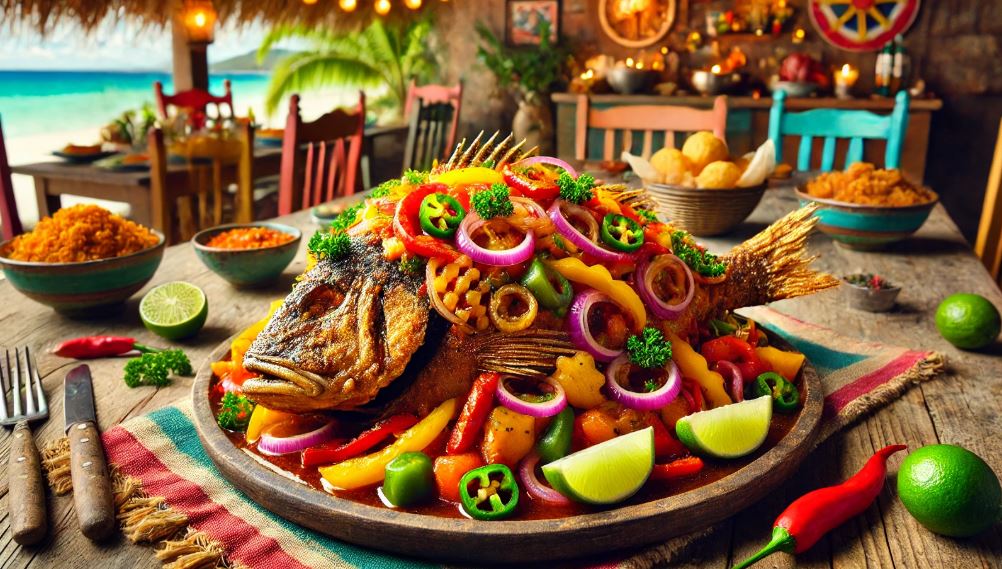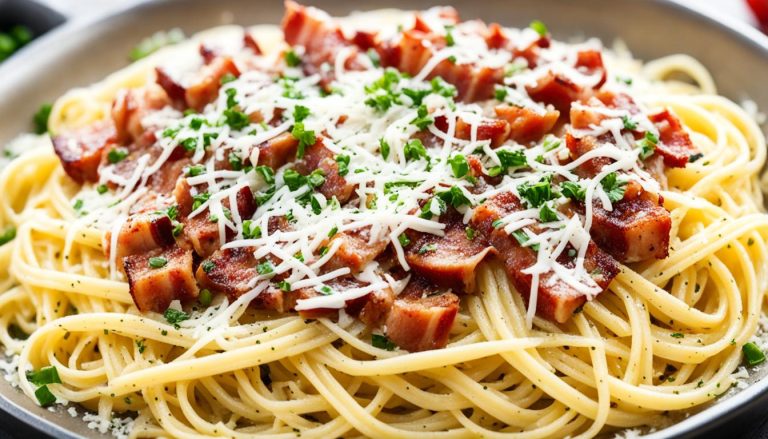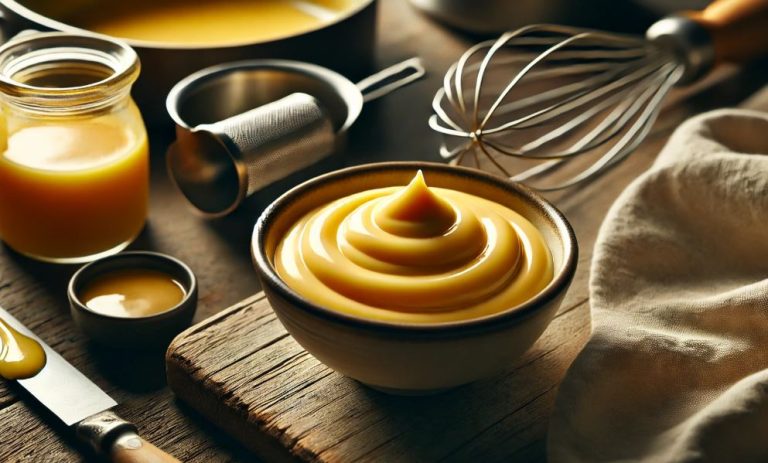Escovitch fish recipe is a staple of Jamaican cuisine, offering a perfect balance of crispy texture and bold, pickled flavour.
This traditional dish features seasoned fried fish topped with a vibrant medley of vegetables soaked in vinegar and spices. Ideal for beginners, this step-by-step guide breaks down the preparation process and explores chef-inspired variations.
Whether you’re new to Caribbean cooking or looking to perfect your technique, this recipe offers an authentic and approachable introduction to escovitch fish.
What Makes Escovitch Fish a Classic Jamaican Dish?
Escovitch fish holds a special place in Jamaican culinary tradition due to its historical background, flavour profile, and popularity during special occasions. It is not only a dish but a cultural symbol representing the island’s fusion of African, European, and Indigenous influences.
Key factors that define its classic status:
- Caribbean seasoning techniques: Use of thyme, pimento, and Scotch bonnet peppers gives the dish its unique Jamaican signature.
- Vinegar-based pickling: A method inherited from Spanish influence, now central to many Jamaican dishes.
- Balance of textures and flavours: The crispy exterior of fried fish contrasts beautifully with the tender, tangy vegetables.
- Common in local celebrations: Often enjoyed at Easter, beach cookouts, and street food festivals.
Traditional escovitch fish stands out due to its preparation method, fresh fish is seasoned with salt, pepper, and pimento, fried in hot oil, and topped with a vegetable medley pickled in vinegar. This results in a harmony of spicy, savoury, and acidic notes that define Jamaican street food.
Escovitch fish has also gained international popularity, featured in Caribbean restaurants across the UK and other countries, making it one of Jamaica’s most iconic exports.
What Ingredients Are Used in an Authentic Escovitch Fish Recipe?
Authentic escovitch fish relies on simple yet flavourful ingredients that combine to produce a rich, zesty profile. While the ingredients may vary slightly based on the chef or household, a few essentials are always included.
Ingredients Table
| Ingredient | Quantity (for 2 Servings) | Notes |
| Whole Red Snapper | 2 medium-sized | Can substitute with kingfish |
| Scotch Bonnet Pepper | 1-2 sliced | Handle with gloves, very spicy |
| Onion | 1 large sliced | White or red onion works |
| Bell Peppers | 1 cup sliced (mixed) | Use red, green, yellow combo |
| Vinegar | ½ cup | White or cane vinegar preferred |
| Lime Juice | 2 tablespoons | Freshly squeezed |
| Pimento Seeds | 1 tsp | Can crush slightly |
| Oil for frying | Enough to shallow fry | Vegetable or sunflower oil |
| Thyme | 2 sprigs | Fresh preferred, can use dried |
| Salt | To taste | Sea salt enhances flavour |
| Black Pepper | 1 tsp | Freshly ground recommended |
| Carrot | 1 medium, julienned | Adds crunch and mild sweetness |
| Garlic (optional) | 1 clove minced | For added depth of flavour |
How to Make Escovitch Fish Recipe?
Making escovitch fish involves a few straightforward steps, each important to achieving the final balance of flavour and texture.
The process includes cleaning and seasoning the fish, frying it until crisp, and preparing the tangy escovitch sauce.
Cooking steps:
1. Clean the fish: Remove scales and gut if necessary. Rinse with lime juice or vinegar.

2. Season thoroughly: Rub with salt, black pepper, and crushed pimento. Let marinate for at least 30 minutes.
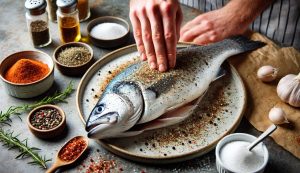
3. Prepare the escovitch sauce: In a pan, sauté sliced onions, bell peppers, carrots, Scotch bonnet, and pimento in a small amount of oil. Add vinegar and simmer for a few minutes to soften vegetables.

4. Fry the fish: Heat oil in a pan, then shallow-fry the fish until golden brown and crispy on both sides.
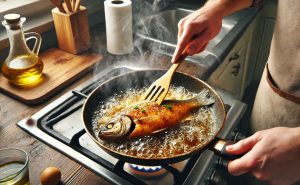
5. Assemble the dish: Lay the fried fish on a serving plate and pour the hot escovitch sauce over it.
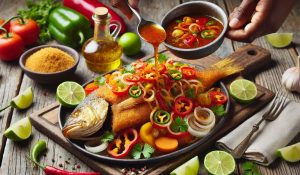
Each stage contributes to the dish’s overall appeal. The marination infuses the fish with island spices, while the vinegar-based sauce brings a sharp contrast that elevates the richness of the fried fish.
How Do You Clean and Prepare the Fish Before Cooking?
Preparing the fish properly is crucial for both flavour and texture. A clean, well-seasoned fish ensures a crisp outer layer and juicy interior once fried.
Preparation Process
- Descale and gut the fish: Remove all scales and internal organs. Rinse thoroughly.
- Wash with acid: Use lime juice or white vinegar to neutralise fishy odours and reduce bacterial presence.
- Pat dry: This ensures the fish fries properly without excess splattering.
- Score the fish: Make shallow diagonal cuts on both sides to help the seasoning penetrate deeply.
- Season generously: Rub the cavity and exterior with salt, pepper, crushed pimento, and thyme.
- Optional marination: Let the fish sit in the fridge for 30 minutes to an hour for deeper flavour.
Proper preparation makes a noticeable difference in the final dish, helping each bite to be tender, flavourful, and crispy.
What’s the Best Way to Fry Fish for Escovitch?
Frying is key to achieving that signature crunch. The method, oil temperature, and timing must be spot-on to avoid undercooked or greasy fish.
Frying Tips
- Choose a deep, heavy-bottomed pan: Cast iron or heavy non-stick pans hold heat well.
- Use neutral oil: Vegetable or sunflower oil with a high smoke point is ideal.
- Heat oil properly: Aim for around 180°C before adding fish. Test with a small piece or wooden spoon.
- Avoid crowding: Fry one fish at a time to maintain oil temperature and ensure crispness.
- Flip only once: Let one side brown fully before turning.
- Drain on paper towels: Helps remove excess oil and keeps the crust crisp.
Frying gives the fish its iconic texture, which pairs perfectly with the tangy escovitch sauce.
How Is the Escovitch Pickle Sauce Made?
The sauce is the heart of escovitch fish. It brings the heat, acidity, and sweetness that characterise the dish.
Sauce preparation steps:
- Sauté vegetables: Use a splash of oil to soften sliced onions, carrots, bell peppers, and Scotch bonnet.
- Add vinegar: Pour in white or cane vinegar once vegetables start to soften.
- Simmer briefly: Allow the mixture to cook for 3–5 minutes. Do not overcook — the vegetables should retain crunch.
- Add pimento and thyme: For depth of flavour, include crushed pimento seeds and fresh thyme sprigs.
- Optional seasoning: A pinch of sugar or salt can be added to balance acidity.
The escovitch sauce should be poured hot over the fish right before serving to fully infuse the flavours.
How Do You Assemble and Serve Escovitch Fish?
Assembly is simple but crucial for presentation and taste. The fish should be served immediately after adding the sauce to maintain texture.
Serving tips:
Place fish on a platter: Lay the fried fish flat and intact.
Pour escovitch sauce: Use a spoon or ladle to cover the fish generously with the hot pickle sauce.
Include side dishes: Common accompaniments are:
- Bammy
- Festival
- Fried plantain
- Rice and peas
Garnish with fresh thyme: Optional but adds aroma.
Escovitch fish is best served warm to enjoy the contrast between crispy fish and hot, acidic vegetables.
What Are Some Variations of the Escovitch Fish Recipe by Different Chefs?

Different chefs bring their own twist to escovitch fish. While the foundation remains the same, these variations help make the dish more accessible or unique.
Notable variations:
- Immaculate Bites: Uses large whole snapper, fried until deeply crisp, with a bold use of thyme.
- Black Foodie: Highlights a vibrant vegetable mix with a sharp vinegar flavour and fried red snapper.
- BBC Food: Offers a simplified version suitable for home cooks, using widely available ingredients.
- The Lemon Bowl: Features a lighter version, using olive oil and pan-frying instead of deep frying.
- Jamaican Foods and Recipes: Stays closest to traditional methods, with heavy use of pimento and scotch bonnet.
Each version preserves the spirit of escovitch while catering to different dietary needs and preferences.
Can You Make Escovitch Fish Without Frying?
Escovitch fish is traditionally fried to achieve its iconic crispy texture, but it can be successfully prepared using alternative cooking methods like baking or air frying.
These methods are ideal for health-conscious individuals or those who prefer to avoid heavy oil use. While the results are slightly different in texture, the overall flavour can remain consistent with proper technique.
Oven-baked and air-fried options
- Oven baking: Preheat the oven to 200°C. Place the seasoned fish on a lightly greased baking tray or in a cast iron skillet. Bake for 20–25 minutes, flipping once midway.
- Air frying: Preheat the air fryer to 190°C. Lightly brush the fish with oil to encourage browning. Cook for 15–18 minutes, flipping halfway through for even crisping.
Taste and texture comparisons
- Baked fish has a firmer, slightly drier texture compared to frying but retains seasoning well.
- Air frying comes closer to traditional frying, delivering a crisp outer layer with less oil absorption.
- Both methods allow the escovitch sauce to shine as the main flavouring component.
Recommended cooking times
| Method | Temperature | Time |
| Oven-Baked | 200°C | 20–25 mins |
| Air-Fried | 190°C | 15–18 mins |
| Shallow Fried | 180°C | 8–10 mins |
Regardless of the method used, the fish should reach an internal temperature of 63°C to ensure it is cooked thoroughly.
What Are Some Tips for Beginners Making Escovitch Fish?
For beginners, escovitch fish can seem intimidating due to its distinct preparation steps and the bold use of spices and vinegar. However, with the right approach and a few tips, it becomes a very manageable and rewarding dish.
Common pitfalls
- Overcrowding the frying pan: This drops the oil temperature, leading to soggy fish.
- Under-seasoning: The fish should be generously seasoned to balance the bold escovitch sauce.
- Using too much vinegar: Overpowering acidity can mask the flavour of the fish and vegetables.
- Not drying the fish properly: This leads to excessive oil splatter and uneven frying.
Prepping before cooking
- Prepare all vegetables in advance and keep them sliced and ready.
- Marinate the fish early, even a few hours ahead if possible.
- Heat oil and test it with a small piece before adding the fish to ensure proper frying temperature.
With these tips in mind, beginners can create a dish that’s both flavourful and authentic, with less stress and more confidence.
How Should Escovitch Fish Be Stored and Reheated?
Escovitch fish stores well due to its vinegar-based topping, which acts as a natural preservative. When properly handled, leftovers can be enjoyed over several days without compromising on taste or safety.
Cooling and storing safely
- Allow the fish and sauce to cool to room temperature before storing.
- Store the fish and escovitch sauce separately if possible to maintain texture.
- Use an airtight container and refrigerate within two hours of cooking.
- Consume within 3 days for best quality.
Reheating methods that maintain texture
- Oven: Preheat to 180°C and warm the fish for 10 minutes on a baking tray to help revive crispness.
- Air fryer: Heat at 160°C for 6–8 minutes.
- Microwave (not recommended): Use only for the escovitch sauce or if texture isn’t a concern.
Can it be frozen and reheated?
Yes, escovitch fish can be frozen.
- Wrap fish tightly in foil or place in freezer-safe containers.
- Freeze for up to 1 month.
- Thaw overnight in the refrigerator before reheating.
Do not freeze the escovitch sauce with fresh vegetables — the texture will degrade. Make a fresh batch for serving.
Proper storage ensures you can enjoy escovitch fish again without losing its essential textures and vibrant flavours.
Conclusion
Escovitch fish combines simple ingredients with dynamic Caribbean flavour to create a dish that is both satisfying and unforgettable. By mastering the balance between crispy fried fish and tangy escovitch sauce, home cooks can recreate a Jamaican classic with ease.
From traditional methods to modern twists, this guide offers everything beginners need to get started. Whether served at a family gathering or enjoyed solo, escovitch fish promises a bold and flavourful culinary experience worth repeating.
FAQs
What kind of fish is best for escovitch?
Red snapper is the traditional and most preferred choice due to its firm texture and flavour. However, other firm white fish like kingfish, tilapia, or mullet also work well for escovitch recipes.
Can I make escovitch fish ahead of time?
Yes, escovitch fish can be made a day in advance. In fact, the flavours often intensify when the fish sits in the pickled sauce overnight. Store it in the fridge and reheat gently before serving.
Is escovitch fish spicy?
It can be, depending on how much Scotch bonnet pepper is used. The pepper adds a fiery kick, but you can reduce or omit it for a milder dish. Always handle Scotch bonnet with care, and use gloves if necessary.
How long should I marinate the fish?
While you can cook it immediately after seasoning, marinating the fish for at least 30 minutes enhances flavour. Some chefs recommend marinating for 1–2 hours for the best results.
Is it necessary to use vinegar in escovitch sauce?
Yes, vinegar is essential to the escovitch sauce. It provides the sharp, tangy base that contrasts beautifully with the richness of the fried fish. White vinegar is commonly used, but cane or apple cider vinegar are also suitable.

Escovitch Fish Recipe
Ingredients
- Whole Red Snappe
- Scotch Bonnet Peppe
- Onion
- Bell Peppers Use red, green, yellow combo
- Vinegar
- Lime Juice
- Pimento Seeds
- Oil for frying
- Thyme can use dried
- Salt
- Black Pepper
- Carrot julienned Adds crunch and mild sweetness
- Garlic
Instructions
- Clean the fish: Remove scales and gut if necessary. Rinse with lime juice or vinegar.Lime Juice, Vinegar
- Season thoroughly: Rub with salt, black pepper, and crushed pimento. Let marinate for at least 30 minutes.Salt, Black Pepper, Pimento Seeds
- Prepare the escovitch sauce: In a pan, sauté sliced onions, bell peppers, carrots, Scotch bonnet, and pimento in a small amount of oil. Add vinegar and simmer for a few minutes to soften vegetables.Whole Red Snappe, Scotch Bonnet Peppe, Onion, Bell Peppers, Thyme, Garlic, Carrot
- Fry the fish: Heat oil in a pan, then shallow-fry the fish until golden brown and crispy on both sides.Oil for frying
- Assemble the dish: Lay the fried fish on a serving plate and pour the hot escovitch sauce over it.


